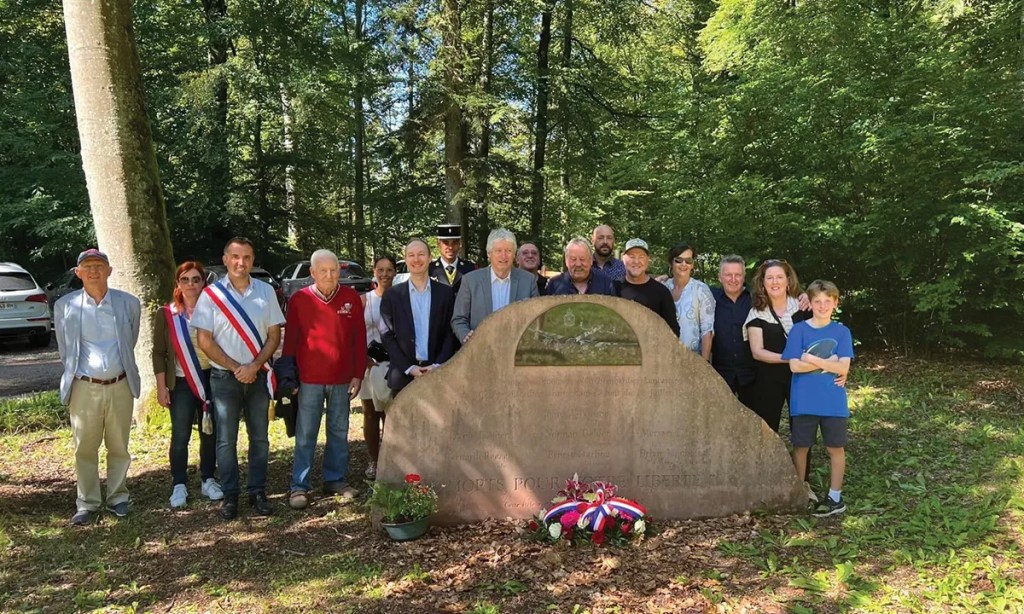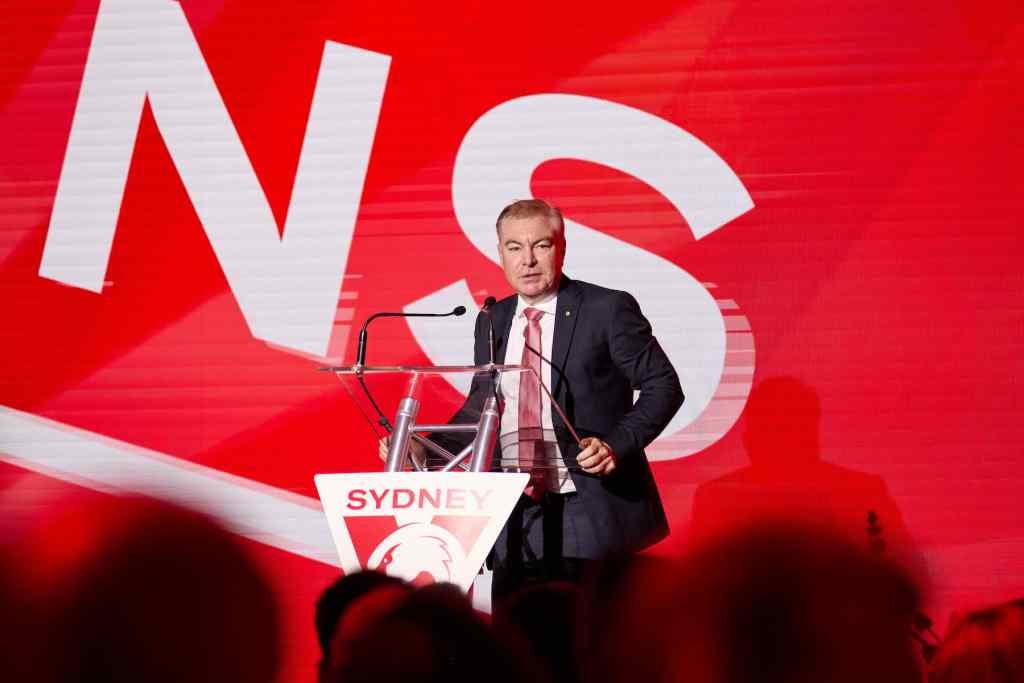Australian World War II bomber’s sacrifice over France

SALIFE features editor Genevieve Meegan will gather with family this weekend at the Australian War Memorial for a very special event. Genevieve’s Uncle John Wilkinson, a Royal Australian Air Force pilot, died along with his crew, after crashing in a French forest during World War II. The remarkable events that followed that crash have formed lifelong connections between countries, families and generations, events that continue to play out to this day. On what would have been John’s 100th birthday, around 40 of his family members will gather for a commemoration ceremony to pay respects to an uncle they never knew but who, through his service and sacrifice, brings them all together in love and honour.
There’s an old black and white photograph of my uncle, John Wilkinson, taken after joining to serve in World War ll. I remember seeing it when I was very young, sitting in a frame on a table at my Nanna’s house.
The photo shows John wearing his Royal Australian Air Force uniform, standing with his legs apart, his hands in his pockets, smiling. He looks so happy and at ease, excited at the prospect of flying out to defend his country. It’s a photo that portrays a charismatic young man with his whole life ahead of him. But, sadly, life had other plans for John Anthony Howard Wilkinson.
John, my mum Elizabeth’s older brother, was a flying officer in the 463 Squadron in WWll.
Based in Europe, this squadron was tasked with flying night raids over Germany and sustained the highest death rate of any Australian squadron during the War – one in two airmen was killed.
On the night of July 28, 1944, John was the pilot of Lancaster bomber ME-615. The plane was heading back from its 15th mission – a bomb attack on Stuttgart, Germany – when it was shot down over German-occupied France, blasted out of the night sky, plummeting to the ground and crashing into dense forest in an area known as Rohrbach-Les-Bitche.
All seven crew were killed instantly.
John was 20 years old.
The story could end there – another heartbreaking example of the futility of war and of lives lost too young.
But it is what happened next that makes this story so remarkable, thanks to the brave actions of a total stranger. Those actions began a chain of events that continue to ripple through our family to this day.
And it is those events that have led me to journey to the very forest in France where my uncle died in that blazing wreckage in 1944.
It’s a hot day when I arrive at the forest, but there’s a slight breeze and dappled sunlight filters through the enormous beech trees in this beautiful slice of the French countryside.
I have come on this personal pilgrimage with my husband Brian, our son Charlie, 12, my brother David, and his wife Ilka Priebe.
Guiding us into the forest is a local man named Norman Grebil. Norman, too, is connected to this story which begins on July 28, 1944.
On the night of the plane crash, Norman’s father Joseph was watching the horrifying raids overhead with his wife Irene. The couple lived in the nearby town of Montbronn and they saw Uncle John’s Lancaster bomber crash into the forest several kilometres from their home.

A photograph of John Wilkinson, in uniform showing off his pilot wings.
Smoke was billowing into the night sky when, in a split-second decision, Joseph decided to ride his bike out to the crash site.
In the dark, and with no clear paths to follow, the Frenchman rode through the rugged terrain, hurrying to get to the plane before the German Investigation Squad could arrive.
Joseph arrived at the scene just before dawn and we can only guess at the carnage that confronted him, but it is what Joseph did next that marks the first chapter in this extraordinary series of events.
He was able to carefully retrieve identification paperwork from some of the bodies, including that of my uncle John. He removed a handwritten note with John’s name, rank and serial number. He also managed to remove the paperwork from another crew man: “Norman F Gelder, warrant officer, service number 409041”.
You might like
In the months following, Joseph hid these pieces of paper until the War was over. He then sent them on to the International Red Cross which was then able to send this personal paperwork onto the families in Australia.
A year after the war, John’s mother (my Nanna) Eileen Wilkinson received that note written in her son’s handwriting: “Wilkinson JAH, skipper, 417547”.
Through his eyewitness account, Joseph was also able to provide precise information about how, when and where the members of Squadron 463 had perished. Up until that point, John’s family had simply been told that he was missing in action, presumed dead.
At the time, John’s younger brother, my uncle Bob Wilkinson, was just 11 years old, but he remembers news of his brother’s death being delivered to their home in Dulwich. “I remember we found out that a man named Joseph Grebil had taken a piece of paper out of John’s pocket,” says Bob, now 90 years old.
“I saw that piece of paper. It had been torn off the bottom of a notepad and it had John’s name, rank and serial number. It came with a letter from the Red Cross in Geneva, which was delivered to our house, outlining how they had received information courtesy of a Monsieur and Madame Grebil and that Joseph had travelled out to the crash site.
“I was only 11 at the time, but I remember thinking that if I ever got to Europe one day, I was going to find that man Joseph and thank him for what he did for our family and for John.”
Decades later, in 1978 Bob found himself in Europe. By then, he was in his 40s and an ordained Catholic priest, attending a conference in Sweden.
Fuelled by gratitude and a brother’s love, Bob set out on a trek to find Joseph Grebil and thank him for what he did for John and his family all those years ago.
“All I had was a name, Joseph Grebil, and a few key places – Strasbourg, Sarreguemines, Bitche and Montbronn,” says Bob.
“I didn’t know where any of them were except Strasbourg and I thought, well, train lines don’t change by and large, so I got myself to Strasbourg just after midday. I remember going up to a noticeboard timetable and I saw a train to Sarreguemines. So, I climbed on board and we made it there, but then there was no more train line, so I said to someone, ‘où es Bitche?”, which means ‘where is Bitche?’ and she said ‘la, va’, which means roughly, ‘there, quick’.

Bob Wilkinson, a Catholic priest, holding a photograph of his big brother John who died during WWII.
“It was a rail car so I ran and jumped on and it went into the forest and I remember it was a lovely afternoon and there were families having picnics. We arrived at Bitche and then I said to someone ‘how do I arrive at Montbronn’ and they said, ‘taxi’, so I got a taxi and arrived at Montbronn at about 6pm. I was on such a high, it was such a win just to find it and to finally be there after all these years.”
Bob found the only hotel in the tiny village and says “I drank myself silly” with excitement.
“Then, I said to the waitress, ‘is there a family here named Grebil and she said, ‘here sir, we are all Schneider or Grebil’, because it’s on the German/French border.
“My French was not great, but when she told me about the Grebils, I picked up the words ‘sage femme’ – it means wise woman or someone who had ‘beaucoup enfant’, lots of children.
“So, I thought perhaps Madame Grebil had lots of children. Then, the next day I walked down the cobbled street and I arrived at a house with a brass plaque that said ‘Madame Irene – Sage Femme, Hebamme’, and that’s when I realised it meant midwife.
“I knocked on the door and a woman opened it and I said in my best school boy French: ‘Bonjour madame, je m’appelle Bob Wilkinson, mon frere John est mort pres ici pendant la guerre’, … ‘hello, my name is Bob Wilkinson and my brother John died here in the War.
“She looked at me for a split second and said ‘entre, vous etes de la famille … come in, you are one of the family’.
“That was after 33 years, it was astounding.”
Bob entered the house where he finally met Joseph and was able to thank him for his bravery.
They drank home-made moselle and Madame Grebil cooked a bacon and egg quiche, apt given they were in the Alsace-Lorraine region of France. Irene was a petite, pretty woman who looked like French singer Edith Piaf, Bob says, while Joseph was a bigger man, the town mechanic and a man of few words.
“Then they asked me, ‘where is your wife?’ and I explained that I was a Catholic priest,” Bob says.
Eventually, talk turned to the night of the plane crash.
“Joseph told me about how they went outside and saw the plane coming down,” Bob says. “He said they were watching the bombers and there had been about 800 planes flying back and forth, with the Germans attacking them. It would have been one hell of a light show.
“We know the raid flew out at 11 at night, coming back at about three in the morning and Joseph would have headed off to the site at about five. It must have been a pretty split-second decision. It’s quite remarkable.

Genevieve with Norman Grebil, standing at the entry of the Grebils’ home where Bob visited in 1978.
“As we chatted, Joseph said to me, ‘now it is possible to drive on a road into the forest’, but back then it was some miles into a shapeless forest, he was on his bike before sunrise using whatever tracks he could remember.
“It was such a risky thing to do because the Germans treated Alsace-Lorraine as German territory, so anybody living there was treated as a German citizen. So, Joseph would have been due for conscription had the Germans caught him, he would have been drafted.”
Bob says as they sat trying to converse in broken French and English, Joseph then said: “One thing I haven’t said much about and please don’t ask me, I won’t talk about the bodies”.
During his stay in Montbronn, Bob visited the forest where the indentation in the forest floor showing where the plane had crashed was still visible.
He then said Mass in the forest, a spiritual outpouring of remembrance and love from a brother who had fulfilled his childhood pledge to come and pay respects.
“I wrote straight away to my mother to tell her about this meeting and she was delighted,” Bob says. “Mum was transported with delight that this had all happened and that I’d said Mass where John’s plane came down.”
Subscribe for updates
Bob remembers his older brother John as funny, sporty and clever, slightly shy, but a natural leader.
John was the eldest boy of the seven Wilkinson children and when their parents (my grandparents) divorced, John shouldered some of the family responsibilities during the 1930s.
After leaving Sacred Heart College, John began a printing apprenticeship, then enrolled in an accountancy course and began work at Elders Trustee and Executor Company. At 16, John had been part of the air cadets and had then joined the Royal Australian Air Force on May 23, 1942. After completing three months of training in Australia, John embarked on the journey to the UK in June 1943. By then he could successfully fly multiple types of aircraft including the Tiger Moth, Wackett Trainer, Anson, Oxford, Lancaster and Wellington.
Hard to fathom such achievements at just 20 years of age.
“He had a touch of that gravitas, you can see how he came to be chosen as a pilot of a crew of six men older than him,” Bob says. “He was funny, but he also had that restraint, he had a certain strength about him.
“He wouldn’t automatically follow the reaction of the group, he was his own person and if he disagreed, he’d say so. He was also a natural leader and very well-liked by people. After he left for the War, Mum said a few times to me she knew she’d never see him again. I don’t know how much of that was fear but that was certainly her disposition.”
Over the years Bob continued to visit Montbronn several times, forming close friendships not only with Joseph and Irene, who have since passed away, but also with their children, Giselle, who now lives in Paris, and Norman, who is guiding us to the forest today.

The forest floor showing the craters left by the Lancaster bomber.
Norman was named after crew member Norman Gelder, and the Gelder family has also made contact with the Grebil family over the years.
Norman explains that as a young man he wasn’t much interested in the story about the allied soldiers who died so close to his home, and his father’s brave actions that night.
But it was after meeting Bob in 1978 that his interest was piqued.
“I was in my 20s then and Bob’s visit sparked something, I realised we had a connection with Australia,” Norman says.
Norman and Bob have even been to the Choloy War Cemetery in France where the remains of my uncle and the other crew members have been buried in graves 7-13.
In 2004, Norman’s dedication to these men culminated in him organising a monument to be erected on the fringes of the forest, bearing the names of all those on board that doomed Lancaster bomber. The monument sits near the side of the road, not far from the path that leads into the crash site. It reads in French:
…En Hommage a l’equipage d’un Bombardier Lancaster du 463 eme Escadron abattu dans la nuit du 28 Jullet 1944:
In tribute to the crew of a Lancaster bomber of the 463rd Squadron shot down on the night of July 28, 1944 John Wilkinson-Pilot, Frank Fischer-Bombardier, Norman Gelder-Navigator, Mervyn Harrison-Gunner, Bernard Reece-Radio, Ernest Starling-Mechanic, Brian Moorehead-Gunner
“Morts Pour Notre Liberte” They died for our freedom
On the day we arrive at the memorial site, Norman has kindly invited local dignitaries and community leaders to meet us, including the mayor.
We gather around the monument and pose for photos for the local newspaper and there are speeches, wreaths and remembrance. Then, as we all begin to walk into the forest, things go quiet.
I can hear branches crunching underfoot as we wander down a small path and then veer into the forest itself.
We walk for about 200 metres before we stop and realise we have arrived at the spot.
Amazingly, still scorched into the forest floor, are giant craters formed by the impact of the Lancaster bomber – huge indentations from the wings, engines and upper part of the fuselage. Almost 80 years on, these craters still fill with rainwater during the French winter. Frozen in time.

Genevieve’s son Charlie laying a wreath at the memorial for his great uncle John Wilkinson. The memorial was unveiled in 2004 on the 60th anniversary of the crash.
As we wander around and examine the ground more closely, we are stunned to find small pieces of the actual plane – mangled pieces of metal lying on the forest floor.
I hold some of the metal in my hand, feeling a connection to an uncle I never knew, who died here so far away from family and friends. I want him to know that we are here now. That he is not alone. That he is remembered and loved. I also think about my darling Mum, who passed away in 2019, who never made it here, despite a couple of attempts. We are also here in her honour – Mum was just 17 years old when her big brother died at war.
After our time in the forest, we move on to drinks at the Town Hall, and I am grateful for the efforts of this tiny local community who have honoured our uncle and his crew, and today, they welcome us so warmly.
I am also grateful that my son Charlie, who laid a wreath at the memorial during our visit, can continue to talk about his Great Uncle John and perhaps visit this forest again in the future – continuing the legacy.
Joining us that day was Norman’s son Marc Grebil who now lives in the former home of his grandparents – the home Uncle Bob visited in 1978.
Marc represents the next French generation of the Grebils who can carry on this remarkable history of remembrance and connection.
In a lovely full circle event, Uncle John has been specifically chosen for a special Last Post Commemoration Ceremony to take place at the Australian War Memorial in Canberra this month.
The date chosen is March 23, 2024, on what would have been John’s 100th birthday.
Uncle Bob will be there to honour his big brother, as will around 50 of Uncle John’s nieces and nephews and extended family, many of whom have also made the trek to Montbronn over the years also guided by Norman.
Celebratory lunches and dinners have been planned over a three-day event in Canberra. At the commemoration ceremony, a serving member of the RAAF will read out Uncle John’s story, the Last Post will be played and representatives from each strain of the family – Wilkinson, Meegan and Kenneally – will lay a wreath.
We will all reflect quietly over those three days, as well as enjoy time reconnecting with cousins we rarely see. We will all also be mindful that he may be an uncle we never knew, who died thousands of miles from home decades ago, but he is forever in our hearts and minds. There is a beauty at the heart of this gathering as, even in death, it is Uncle John who reunites us through his bravery and sacrifice.
On what would have been his 100th birthday, we will all raise a glass to celebrate John Anthony Howard Wilkinson – a son, a brother, a solider, a friend – and an uncle who will be remembered, honoured and loved, that day and always.
Lest we forget.
This article has been written with the help of research done by Genevieve Meegan’s nieces, Beth Neate and Sadie Schultz.
This article first appeared in the November 2023 issue of SALIFE magazine.




